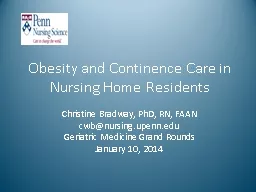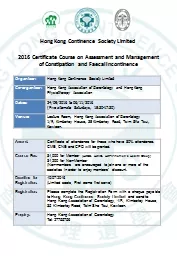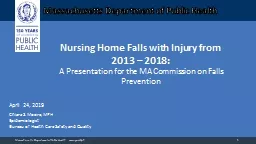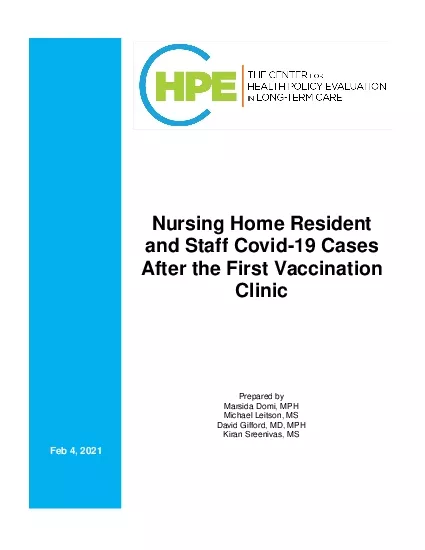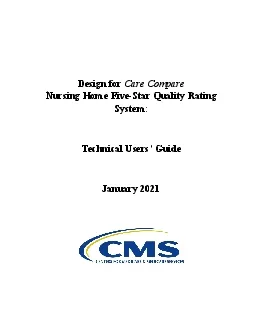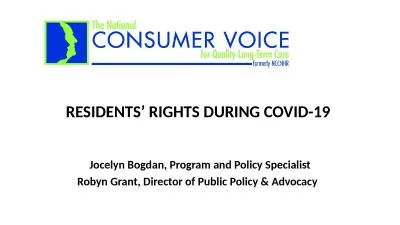PPT-Obesity and Continence Care in Nursing Home Residents
Author : mitsue-stanley | Published Date : 2016-03-08
Christine Bradway PhD RN FAAN cwbnursingupennedu Geriatric Medicine Grand Rounds January 10 2014 Objectives 1 Describe the demographics and consequences of obesity
Presentation Embed Code
Download Presentation
Download Presentation The PPT/PDF document "Obesity and Continence Care in Nursing H..." is the property of its rightful owner. Permission is granted to download and print the materials on this website for personal, non-commercial use only, and to display it on your personal computer provided you do not modify the materials and that you retain all copyright notices contained in the materials. By downloading content from our website, you accept the terms of this agreement.
Obesity and Continence Care in Nursing Home Residents: Transcript
Christine Bradway PhD RN FAAN cwbnursingupennedu Geriatric Medicine Grand Rounds January 10 2014 Objectives 1 Describe the demographics and consequences of obesity and UI 2 Examine . What is a nursing home?. Facility that provides 24 hour care. Staffed by licensed nursing professionals. Residents may receive assistance with any and all tasks of daily living. What is a nursing home?. Enq Continence Care All Party Parliamentary Group For Continence Care Report @ fthcd enq bnllhrrhnmdqr vqhssdm ax bnmshmdmbd baqd oqnedrrhnmakr . Paediatric Continence . Service . Toileting Drop . in . clinics. All are welcome . Come for . practical advice on . potty training . and . toileting . that is proven to . work. Meet: . the . continence specialist nurse to answer your . 2016 Certificate . Course . on . Assessment and Management of . Constipation and . Faecal. Incontinence. Organizer:. Hong Kong Continence Society . Limited. . Co-organizer:. Hong Kong Association of Gerontology and . The . Obesity Algorithm is reviewed and updated yearly to reflect the newest and most relevant information. The 2017 version includes new sections or updates on:. Recommendations . for setting up your office to accommodate all patients. Kimberly K Kopp. BSN, RN, CWOCN, CFCN. LEARNING OUTCOMES. Participants will be able to: . Facts . Financial burden . –. . Year 2000 estimated . at $19.5 . billion. . $14.2 billion incurred by community residents . 2013 – 2018: . A Presentation for the MA Commission on Falls Prevention. April 24, 2019. Chiara S. Moore, MPH. Epidemiologist. Bureau of Health Care Safety and Quality. 1. Massachusetts Department of Public Health mass.gov/dph. and Staff Covid19 CasAfter the First Vaccination ClinicPrepared byMarsida Domi MPHMichael Leitson MSDavid Gifford MD MPHKiran Sreenivas MSFeb 4 2021x0000x0000COVID Cases fterNursing Home Vaccine Clini x0000x0000 x/MCIxD 0 x/MCIxD 0 On December 1 2020 the Nursing Home Compare website was retired It has been replaced by the new Care Compare website Care Compare can be accessed at https//wwwmedicarego William A. Monaco, OD, MSEd, PhD. University of South Florida. John E. Crews, DPA. 1. Chronology of the Problem and How I Became Interested. Origin serendipitously in the year 2000. I began exploring the need for nursing home eye care in Washington, D.C. – by contacting local nursing homes.. Continence. Society. . Paediatric. . Continence. . Care. by. M De Gennaro, J Chase, T . Neveus. & . ICCS Board . ICCS - . Paediatric. . Continence. . Care. by. M De Gennaro, J Chase, T . Jocelyn Bogdan, Program and Policy Specialist. Robyn Grant, Director of Public Policy & Advocacy . Right to Receive Care and Services to Obtain Highest Level of Well-being . Attain and maintain highest level of physical, mental, and psychosocial well-being. Liz Wells Health Visitor . Aoife Price Health Visitor May 2021 . Health Visiting Service . Website: . www.ghc.nhs.uk. . Add you Contact details here ……. eg. . Health Visitors . Office,Stroud. presented by:. Ekezie. . Ralueke. . Oluchukwu. . RN,. CEO Blue Torch Home Care Limited. ralueke@bluetorchhomecare.org . Abstract . Tele-health integration into home care Nursing is a revealing mirror in the health care system , producing the image visibility , stability, sustainability with importance of Information and Communication Technology (ICT) in Home Care Nursing Practices and health care system at large. According to (Global observatory for .
Download Document
Here is the link to download the presentation.
"Obesity and Continence Care in Nursing Home Residents"The content belongs to its owner. You may download and print it for personal use, without modification, and keep all copyright notices. By downloading, you agree to these terms.
Related Documents

